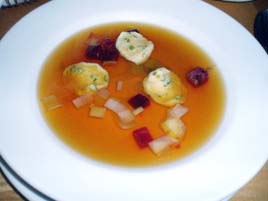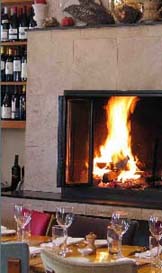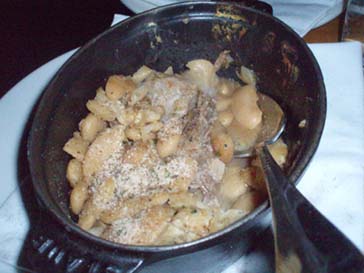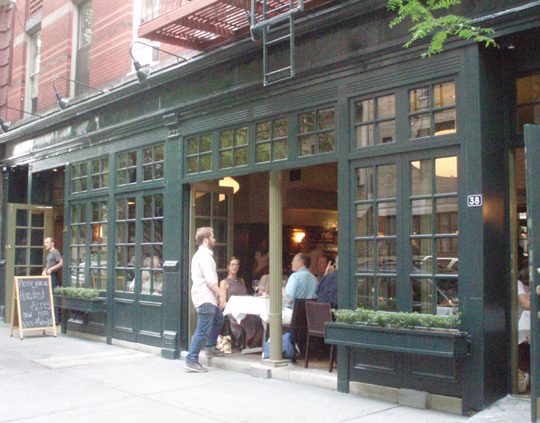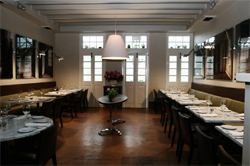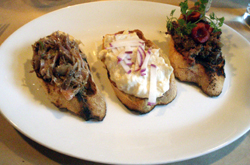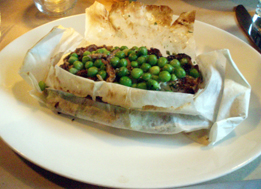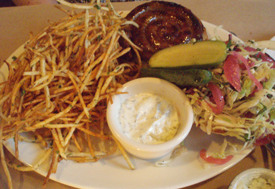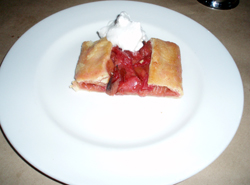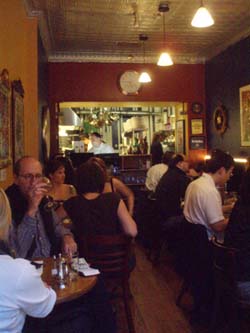Osteria Morini
 Monday, November 1, 2010 at 03:42PM
Monday, November 1, 2010 at 03:42PM 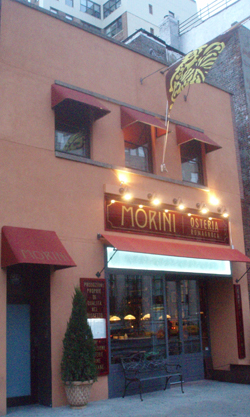 What a wild rocket-ride Michael White has had. Four years ago, he was the relatively unheralded chef at Stephen Hanson’s Fiamma. The restaurant was a solid three-star, but the chef’s name didn’t roll off the tongue.
What a wild rocket-ride Michael White has had. Four years ago, he was the relatively unheralded chef at Stephen Hanson’s Fiamma. The restaurant was a solid three-star, but the chef’s name didn’t roll off the tongue.
Today, White is as close to culinary royalty as any chef in this town who doesn’t have four New York Times stars. His three established places (Alto, Convivio, and Marea) have nine NYT stars, and also five Michelin stars. No other NYC chef has more than two Michelin-starred restaurants, nor more than four stars in total.
Mario Batali is a better known Italian chef than White, but Batali hasn’t actually cooked in years, except on television. White really works in his restaurants.
This fall brings a dual test, as Osteria Morini, his latest place, has just opened; another, Ai Fiori, is forthcoming in the new Setai Fifth Avenue.
The obvious questions are: 1) Is there such a thing as too much Michael White? And 2) Can his restaurants remain as good, when his time is split among five of them? To answer the second question, we’ll have to wait a while. For now, we can answer the first: when they’re as good as Morini, White can open as many restaurants as he wants.
The focus here is on the cuisine of the Emilia-Romagna region, known for hearty, uncomplicated fare. The word Osteria signals a more informal approach to Italian food: no tablecloths, no expensive prix fixe.
This was clearly meant to be the casual cousin to the chef’s earlier restaurants. As Frank Bruni noted in a blog post:
Its unvarnished sensibility will be reflected in its décor, which uses antiques and other materials plucked or salvaged from flea markets and farmhouses throughout Italy.
Still, with pastas priced at $17–19 and entrées $24–42, these aren’t cheap eats. It’s quite a bit more than White and his partner, Chris Cannon, told the Times just six months ago. At these prices, they could afford to ditch the paper napkins and the garish orange paper placemats. The loud rock sound track is probably the restaurant’s least authentic amenity; it ought to go, too.
But that is about all we would change at Osteria Morini, which is already a great restaurant after only a month in business.


Musseto ($13; above left) was a hearty stew of braised cockscombs, sweetbreads, calves feet, garlic croutons, and salsa verde. Nine out of ten diners would probably reject it for the “ick” factor alone, but I couldn’t actually distinguish the specific taste of any ingredient except the croutons.
Mozzarella ($11; above right) paired happily with figs and rosemary oil.
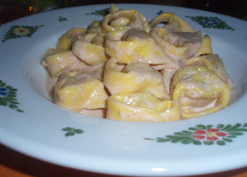
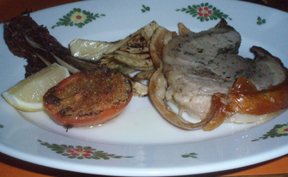
The pasta section of the menu is loaded with shapes and flavor combinations I have never seen before, all made in house. While Tortellini ($18; above right) may be common, the duck liver cream sauce it came with was not. It was an excellent dish, but it needed to be just a shade warmer.
White roasts Porchetta ($29; above right) with sage and rosemary on a spit for three hours, wrapped in thick, crackling skin. The pork was beautifully cooked, as tender as butter.

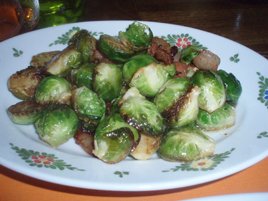
Petroniana ($27; above left), a crispy veal cutlet, is so rich that it could be dessert, putting the old classic to shame, with layers of prosciutto, parmigiano, and truffle cream, served on a bed of buttered spinach. We debated whether this dish was too heavy for its own good—it was certainly impossible to finish—but I would order it again.
Cavoletti Bruxelles & Pancetta ($9; above right), or Brussels Sprouts, were an excellent side dish, but honestly there was no need to order them, as the rest of the meal was already far too filling.
The wine list is excellent for this type of restaurant, with many unfamiliar wines (Talia Baiocchi published an overview last week). I checked in on foursquare, and within minutes a stranger directed my attention to a white wine fermented in its skin, in a section of the menu captioned “Vini Bianchi da Contemplazione.” These wines have a slightly orange hue and an arch, crisp flavor that pairs well with the cuisine. We had the Notte di Luna, which at $69 seemed to us a very good deal for something so unusual.
A restaurant in such high demand—and Morini is about as hot as any right now—could quickly become full of itself. There is none of that here. The staff volunteered without prompting to transfer our bar tab to the table (Ahem! Paging Jeffrey Chodorow). And when we stopped Chef White to ask how a dish was prepared (the Porchetta), he insisted on finding a piece of paper so that he could draw a diagram, and then took us into the kitchen to show us how it worked. (We are reasonably certain he did not recognize us as bloggers, because it was the end of the meal, and he had paid no attention to us before that point.)
Chef White is juggling four high-profile restaurants, soon to become five. To maintain quality at all of them will be a challenge. We can’t forecast how he’ll manage that. Right now, while Osteria Morini has his full attention, it’s everything we hoped it would be.
Osteria Morini (218 Lafayette Street between Broome & Spring Streets, Soho)
Food: **
Service: **
Ambiance: *
Overall: **



























